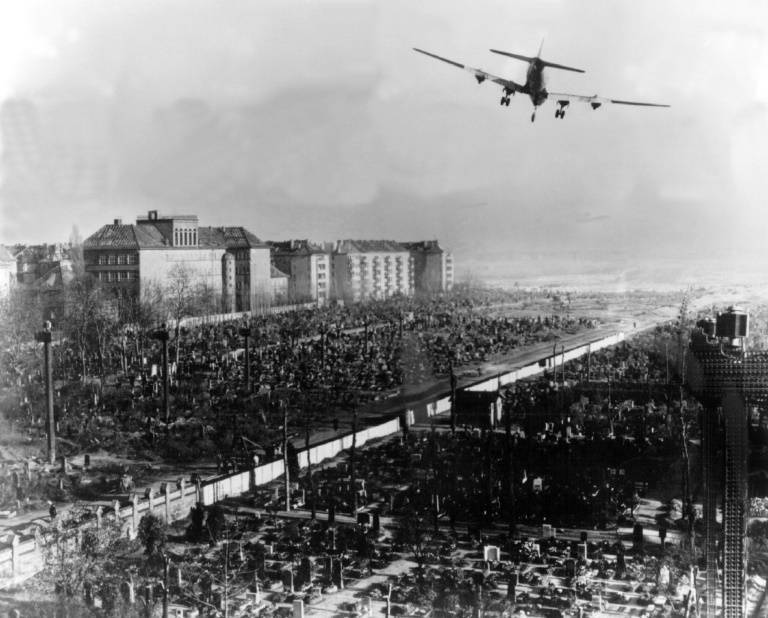Germany marks 70 years Tuesday since the start of the Berlin Airlift, a spectacular humanitarian rescue mission amid the first major Cold War crisis between the West and Soviet Union.
For almost a year, mainly American and British pilots created a lifeline to support war-ravaged West Berlin, then encircled and blockaded by Soviet forces, with food and fuel.
The unprecedented 1948-49 effort to save the city from starvation cemented the post-war German-American friendship.
Here are five things to know about one of the greatest feats in aviation history.
WWII ends, Cold War begins
After the defeat of Nazi Germany, tensions between the West and Soviet Union resurfaced to divide most of the world into two rival, nuclear-armed camps until the 1989 fall of the Berlin Wall.
In 1945, the four victorious powers -- the United States, Britain, France and Russia -- split up defeated Germany into four occupation zones, a division mirrored in the capital Berlin.
This left West Berlin, controlled by the Western Allies, stranded like an island deep inside the Soviet sector, which would later become walled-off communist East Germany.
To the western powers, West Berlin became a symbolic bulwark of freedom a sentiment US president John F. Kennedy would later express with the words "I am a Berliner".
Blockade of a shattered city
Soviet dictator Joseph Stalin wanted to push the western powers out of West Berlin -- then a starved city of 2.2 million where entire city blocks were little more than rubble.
The western Allies instead opted in 1948 to unite their zones into a single economic area with a new Deutschmark currency, paving the way for the creation of West Germany.
In response, Soviet troops on June 24 launched a full blockade of West Berlin, whose people were already scavenging for food and where hyperinflation had made cigarettes the black-market currency.
Citing "technical reasons", the Soviets closed all roads, railway lines and waterways to the city and shut off electricity.
With fears rising that Europe was on the brink of World War III, the western Allies launched an unprecedented rescue effort for the hugely symbolic city.
Spectacular rescue mission
Starting on June 26, the Allies launched their "air bridge" to fly food and fuel into the besieged city -- scaled up soon to see a landing or takeoff in Berlin every 90 seconds.
To break the 322-day blockade, some 277,000 flights brought in more than two million tonnes of relief goods and CARE food packages.
The planes travelled a total of 175 million kilometres (108 million miles) -- the equivalent of flying around the Earth 4,400 times.
During the operation, Berlin mayor Ernst Reuter made a passionate appeal: "People of the world, people in America, in England, in France, in Italy: Look at this city and see that you should not, you cannot abandon this city and this person"
The Soviets finally lifted the blockade on May 12, 1949, though the flights continued for several more months.
The daring air bridge claimed at least 78 lives, mostly of US and British pilots.
Uncle Wiggly Wings
Berliners fondly remember the buzzing propellers' "sound of freedom" and the "Candy Bombers" whose pilots threw sweets and raisin packages from the skies on self-made parachutes.
The first airman to do so was US pilot Gail Halvorsen, who announced himself with a signature aircraft tilt that earned him the nickname "Uncle Wiggly Wings".
Soon others followed with the hearts and minds campaign, remembered Alexander Kulpok, now 78.
"I could see the pilots in their cockpits and wave at them," he said, adding that as a nine-year-old, he didn't run for the candies because "I didn't want to risk a beating" from the bigger kids.
While, during the war, he said, the sound of aircraft had terrified Berliners, "now we were most worried at those times when it stopped".
Hipster revamp
West Berlin used several airstrips, and a river for water-planes, but the main air hub was Tempelhof, whose giant terminal had been designed fit for the Nazis' "thousand-year Reich".
It closed in 2008, replaced by two other airports, and two years later was declared a vast city park, with skaters and joggers speeding down its old runways.
Berliners voted to keep it that way, rejecting city development plans in a 2014 referendum.
After Germany's mass migrant influx, its buildings housed refugees from other wars, in Syria, Iraq and Afghanistan.
Today families fly kites where the planes once thundered through the sky, hipster gardeners grow organic vegetables, and a memorial honours the pilots who died to keep West Berlin alive.
If all goes well, dozens of the Candy Bombers will fly over Berlin once more in June 2019 celebrations planned to mark the end of the blockade.






